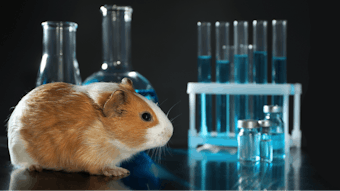CeeTox has reported positive results from the recent phase of a PETA-funded validation study performed by the Flemish Institute for Technological Research (VITO)’s Applied BIO & Molecular Systems (ABS) team. The study confirms the ability of a second laboratory to perform CeeTox’s SenCeeTox skin sensitization assay to correctly classify chemicals as sensitizers or non-sensitizers.
The SenCeeTox assay can categorize chemicals according to their potency. The results of the SenCeeTox trial conducted at VITO-ABS accurately predicted the ability to elicit a sensitization reaction for all 10 blinded compounds tested. Furthermore, it predicted the exact sensitization potency category for 9 out of the 10 compounds, classifying the 10th compound by only a one potency category difference. CeeTox transferred the method for its SenCeeTox assay to VITO-ABS’s laboratory in Belgium as part of a blinded ring-trial funded by PETA U.K. Ring-trials are used to ensure that one laboratory’s results can be successfully replicated in other laboratories. This represents the first nongovernmental organization (NGO)-funded validation study of a non-animal method for regulatory use.
After initial training, CeeTox provided VITO-ABS with a blinded set of 10 compounds. VITO-ABS tested the compounds in its lab and provided the data to CeeTox. The data was run through the proprietary CeeTox algorithm to predict an expected sensitization potency level, unblinded, and then compared to expected results.
Because the results from the SenCeeTox assay have been so promising, further validation of this assay will be continued by Cosmetics Europe, after which all results will be submitted to the European Union Reference Laboratory for alternatives to animal testing (EURL ECVAM).
As part of the SenCeeTox assay, three dimensional, human, reconstructed epidermis (RHE) tissues are treated with multiple concentrations of each test article. This RHE skin model accurately replicates barrier properties, and possesses many of the key functional traits, signaling pathways and metabolic enzymes of normal human skin. After incubation, the skin tissues are then tested to assess the cytotoxic effect and reactivity of the test substances as well as gene expression of key genes along the Nrf2/Keap1/ARE signaling pathway, the activation of which leads to skin sensitization. Finally, the data are analyzed using a proprietary algorithm to predict the chemical’s likelihood of causing a human sensitization reaction.
"This PETA-funded trial is an important step toward validating a reliably predictive full replacement non-animal test for regulatory use," says Tim Mitchell, president of CeeTox Inc. Validation of this testing method is particularly timely in light of the ban on sales of cosmetics in Europe that have been tested on animals. Additionally, this test is important in light of the 2018 REACH deadline, which will require a large number of chemicals to be tested for their ability to induce skin sensitization.




![A 2019 petition to the House of Commons stated, 'We, the undersigned residents of Canada, draw the attention of the House of Commons ... [that] animal testing is unnecessary to prove the safety of cosmetic products.'](https://img.cosmeticsandtoiletries.com/files/base/allured/all/image/2023/01/animal_testing_ban_canada_dreamstime_m_215632720.63d313232306d.png?auto=format%2Ccompress&fit=crop&h=191&q=70&rect=0%2C73%2C1800%2C1013&w=340)





